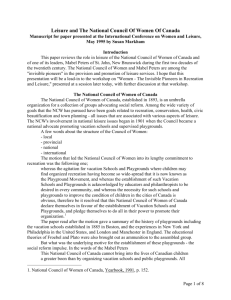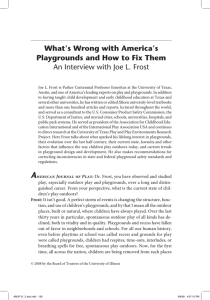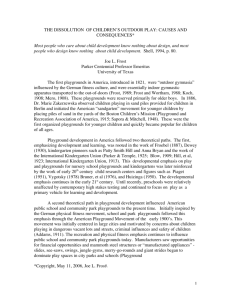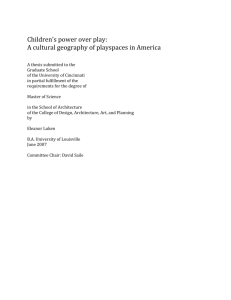Environments for Play
advertisement
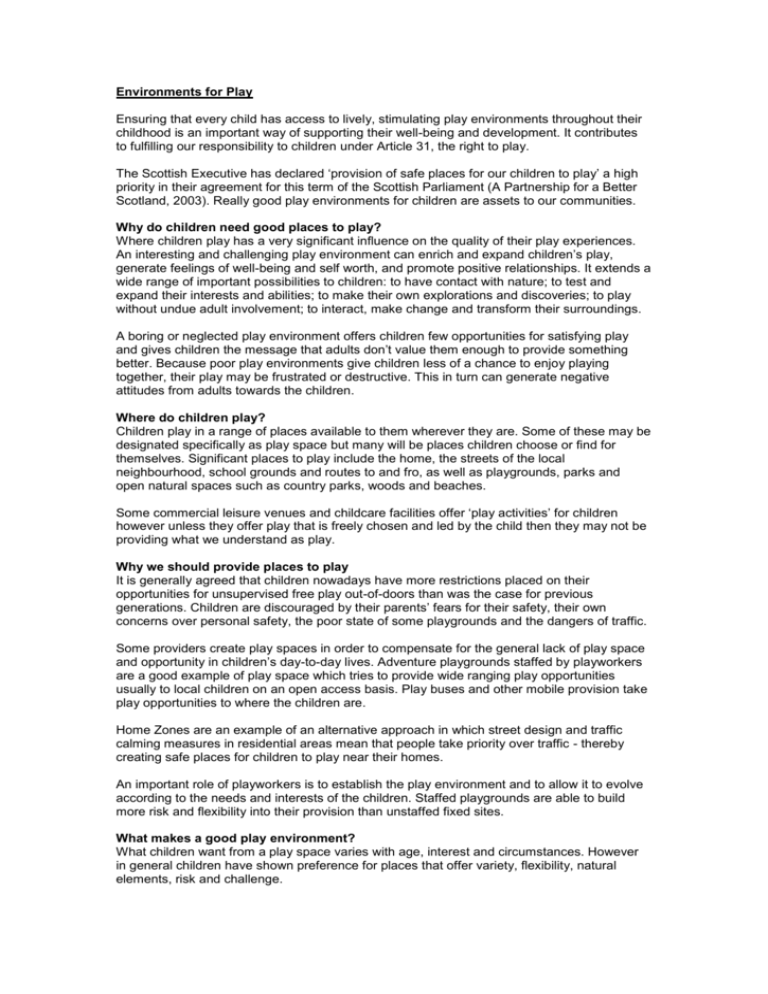
Environments for Play Ensuring that every child has access to lively, stimulating play environments throughout their childhood is an important way of supporting their well-being and development. It contributes to fulfilling our responsibility to children under Article 31, the right to play. The Scottish Executive has declared ‘provision of safe places for our children to play’ a high priority in their agreement for this term of the Scottish Parliament (A Partnership for a Better Scotland, 2003). Really good play environments for children are assets to our communities. Why do children need good places to play? Where children play has a very significant influence on the quality of their play experiences. An interesting and challenging play environment can enrich and expand children’s play, generate feelings of well-being and self worth, and promote positive relationships. It extends a wide range of important possibilities to children: to have contact with nature; to test and expand their interests and abilities; to make their own explorations and discoveries; to play without undue adult involvement; to interact, make change and transform their surroundings. A boring or neglected play environment offers children few opportunities for satisfying play and gives children the message that adults don’t value them enough to provide something better. Because poor play environments give children less of a chance to enjoy playing together, their play may be frustrated or destructive. This in turn can generate negative attitudes from adults towards the children. Where do children play? Children play in a range of places available to them wherever they are. Some of these may be designated specifically as play space but many will be places children choose or find for themselves. Significant places to play include the home, the streets of the local neighbourhood, school grounds and routes to and fro, as well as playgrounds, parks and open natural spaces such as country parks, woods and beaches. Some commercial leisure venues and childcare facilities offer ‘play activities’ for children however unless they offer play that is freely chosen and led by the child then they may not be providing what we understand as play. Why we should provide places to play It is generally agreed that children nowadays have more restrictions placed on their opportunities for unsupervised free play out-of-doors than was the case for previous generations. Children are discouraged by their parents’ fears for their safety, their own concerns over personal safety, the poor state of some playgrounds and the dangers of traffic. Some providers create play spaces in order to compensate for the general lack of play space and opportunity in children’s day-to-day lives. Adventure playgrounds staffed by playworkers are a good example of play space which tries to provide wide ranging play opportunities usually to local children on an open access basis. Play buses and other mobile provision take play opportunities to where the children are. Home Zones are an example of an alternative approach in which street design and traffic calming measures in residential areas mean that people take priority over traffic - thereby creating safe places for children to play near their homes. An important role of playworkers is to establish the play environment and to allow it to evolve according to the needs and interests of the children. Staffed playgrounds are able to build more risk and flexibility into their provision than unstaffed fixed sites. What makes a good play environment? What children want from a play space varies with age, interest and circumstances. However in general children have shown preference for places that offer variety, flexibility, natural elements, risk and challenge. A recent, very useful attempt to define what might make up a stimulating and satisfying play environment is found in Best Play (NPFA, 2000): ‘Criteria for an enriched play environment: A varied and interesting physical environment Challenge in relation to the physical environment Playing with natural elements Movement – e.g. climbing, balancing Manipulating natural and fabricated materials Stimulation of the five senses Experiencing change in the natural and built environment Social interaction Playing with identity Experiencing a range of emotions’ An earlier example is found in Nicholson’s theory of loose parts (1971). Nicholson proposes that there is a relationship between flexible environments and the level of creativity and inventiveness that they support. We can readily relate to the classic example of a ‘loose parts environment’, the seashore, with its shifting elements of water, sand, flotsam and jetsam. Risk and challenge The Play Safety Forum (2002) found that fear of litigation is leading many play providers to focus on minimising the risk of injury in play provision at the expense of quality of play. The effect is ‘to stop children from enjoying a healthy range of play opportunities, limiting their enjoyment and causing potentially damaging consequences for their development’. Elements of risk in play provision bring positive benefits. Children learn to assess risk for themselves and understand the consequences of risk taking. It satisfies a need to test oneself and challenge one’s capacities. While not exposing children to unacceptable levels of risk of harm, play providers should aim for a balance between risks and benefits, on the basis of a risk assessment. Involving children Consideration should always be given at the earliest stages of developing a play environment to the different needs of its potential users. Design of the play environment, both physical and organisational, should ensure that disabled children can access the play opportunities alongside other children from the community. Children’s ongoing participation in designing and developing a play space over time can help to ensure that it really meets the needs of its primary users. In adventure playgrounds children are involved in physically changing and building elements of the play environment. Legal requirements Good practice suggests the need for clear policies and procedures in relation to all aspects of the play environment. These should be based on knowledge of play and children’s needs as well as relevant guidance, regulations and standards. It is vital to stay up-to-date with these. Play providers should be aware of their responsibilities under The Disability Discrimination Act 1995, The Children Act (Scotland) 1995, The Regulation of Care (Scotland) Act 2001 and The Management of Health and Safety at Work Regulations (1992). Providers of out-door, fixed, open-access equipment should also be aware of guidelines for equipment and surfacing standards contained in BS EN 1176 and 1177. NPFA, PLAYLINK, RoSPA and Play Scotland are all good sources of information and advice. Theresa Casey, September 2003 References NPFA (2000) Best Play – what play provision should do for children. London: NPFA/Children’s Play Council/PLAYLINK Nicholson, S. (1971) How not to cheat children: the theory of loose parts, Landscape Architecture Quarterly, 62(1): 30-4 Play Safety Forum (2002) Managing risk in play provision: a position statement. London: Children’s Play Council Home Zones www.homezonenews.org.uk Useful websites: www.thelighthouse.co.uk/playingplaces www.gainplayground.co.uk (playground in Europe, Lewis) www.ltl.org.uk/scot.html (Grounds for Learning) www.freeplaynetwork.org.uk







